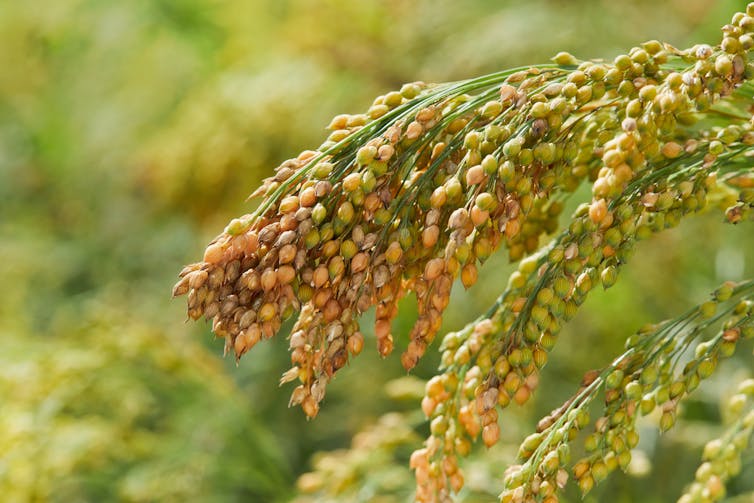The UN estimates that the floods which besieged Pakistan in the summer of 2022 have affected 33 million people, with over 2 million homes destroyed and over 8 million people displaced in a region which already struggles with high rates of malnutrition.
A recent report showed that the flooding followed severe heat. Parched land cannot easily absorb water from swollen rivers and the soil will need time to recover, delaying the sowing of next season’s crops. Receding flood waters are also more likely to leave pastures contaminated by harmful microbes such as salmonella.
When floods last devastated Pakistan in 2010, an analysis by the International Food Policy Research Institute argued that, as a country with just under 40% of the population employed in agriculture, Pakistan needed to invest in the recovery of its farming sector as a priority.
The recent inundation of fields has destroyed standing crops of commercial rice and cotton and those which are consumed in the country, like tomatoes and onions. It has also shrunk the area of land available to grow more food. Resulting cuts to food production will force Pakistan to import produce from abroad. As Pakistan tries to rebuild its agriculture, the world should pay attention: other countries must also learn how to create food systems which can withstand a turbulent future.
Pakistan’s farms are irrigated by the Indus, one of the longest rivers in the world. Glaciers of the Hindu Kush Himalaya mountain ranges sustain her five major tributaries, but they have shrunk since the 1970s. The latest IPCC report showed that snow cover in these mountains is melting more rapidly than in previous decades, raising the volume of water in rivers and making flooding more likely.
Food production globally relies on river waters fed by the predictable melting of glacial ice in summer months. Supplies of wheat, rice and maize that make up just over 70% of the cereal consumed worldwide will not remain secure if glaciers continue to destabilise. Retreating glaciers and increasing droughts followed by more frequent floods will slash food production in the European Alps, Scandinavia and the Tibetan Plateau. The past decade has already seen extreme weather in Italy preventing the cultivation of the prized risotto variety of rice.

Climate-proofing agriculture
The cultivation of large-grain cereals like wheat and rice has become the norm in South Asia since the 1960s. Wheat is the primary crop grown in the flooded provinces of Punjab and Sindh, for example. Agricultural scientists suggest that millets would be more suitable. These “pseudograins” come from broad-leafed plants with small seeds that were very popular in earlier centuries and can be turned into flour to make dough. Along with amaranth and fonio (two more crops with small, hardy seeds), millets are increasing in popularity globally. A recent market analysis indicated that the production of these ancient grains could grow, as increasing global demand is expected to increase at a compound annual rate of 26% between 2022 and 2030.
Cultivating a wider choice of crops would let farmers compensate for falling yields as intensifying heatwaves make wheat cultivation increasingly difficult.

These alternative grains are typically favoured by farmers with less than two acres of land in Asia and Africa. Their cultivation could reduce poverty in these rural communities by allowing farmers to sell their produce in global markets.
Flood-ravaged regions of Pakistan must return to food production and escape hunger as soon as possible. Given the quickening cycles of drought and flooding triggered by global heating, growing hardier alternative crops makes sense. And as water becomes less reliable, crop production could be stabilised by modifying water mangagement systems, including a switch to drip irrigation which saves water by laying pipes which trickle moisture on or below the soil.
A greater selection of crops could also offer a more diverse diet for local people. In the province of Khyber Pakhtunkhwa, only 10% of vegetables grown are processed locally, giving this food a short shelf life and preventing farmers from selling their produce in Pakistan. Investment in transport and storage to reduce spoilage could enable a thriving vegetable trade between provinces.
Resilient food systems in other parts of the world could emulate these proposed changes in Pakistan by diversifying crops to include older, hardier varieties, adopting water conservation methods and helping communities grow both cereals and vegetables which can be eaten locally, for better nutrition and more secure livelihoods.

Don’t have time to read about climate change as much as you’d like?
Get a weekly roundup in your inbox instead. Every Wednesday, The Conversation’s environment editor writes Imagine, a short email that goes a little deeper into just one climate issue. Join the 10,000+ readers who’ve subscribed so far.

